nanDECK - What's new in version 1.12a
![]() New DICE
directive
New DICE
directive
With this command you can create a "dice" and use it to obtain random values. For example, this script shows the sum of three best roll from four dice with ten faces each:
DICE = 1, A, "1-10", 4, +3+
FONT = Arial, 72,, #000000
TEXT = 1, "{A}", 0, 0, 100%, 100%
![]() New label
function FRAMELINE
New label
function FRAMELINE
This function creates a frame group for a line between two frames, for example:
[hex] = FRAMEHEX(0, 0, 6, 9, 0.5, C)
[group] = FRAMELINE(hex0208, hex0603)
POLYGON = 1, <group>, 6, 90, #FF0000
HEXGRID = 1, 0, 0, 6, 9, 0.5,, #000000, EMPTY, 0.1
This is the result:
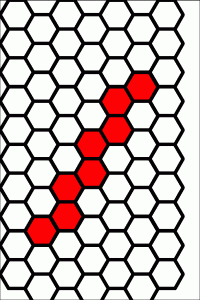
![]() New label
function FRAMEDISK
New label
function FRAMEDISK
This function creates a frame group for a disk with a frame as a center and another frame on the diameter, for example:
[hex] = FRAMEHEX(0, 0, 6, 9, 0.5, C)
[group] = FRAMEDISK(hex0405, hex0403)
POLYGON = 1, <group>, 6, 90, #FF0000
HEXGRID = 1, 0, 0, 6, 9, 0.5,, #000000, EMPTY, 0.1
This is the result:
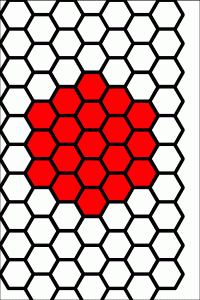
![]() New label function FRAMERECT
New label function FRAMERECT
This function creates a frame group for a rectangle between two frames, for example:
[hex] = FRAMEHEX(0, 0, 6, 9, 0.5, C)
[group] = FRAMERECT(hex0305, hex0609)
POLYGON = 1, <group>, 6, 90, #FF0000
HEXGRID = 1, 0, 0, 6, 9, 0.5,, #000000, EMPTY, 0.1
This is the result:
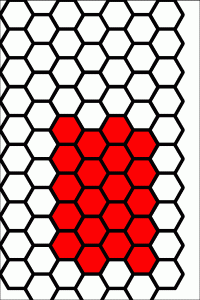
![]() New label function FRAMETRI
New label function FRAMETRI
This function creates a frame group for a triangle between three frames, for example:
[hex] = FRAMEHEX(0, 0, 6, 9, 0.5, C)
[group] = FRAMETRI(hex0204, hex0602, hex0609)
POLYGON = 1, <group>, 6, 90, #FF0000
HEXGRID = 1, 0, 0, 6, 9, 0.5,, #000000, EMPTY, 0.1
This is the result:
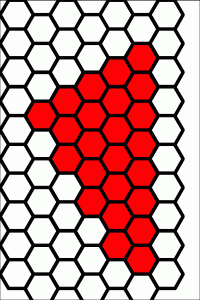
![]() New label function FRAMEMELD
New label function FRAMEMELD
This function creates a single new frame, melding all the frames used as parameters, for example:
[hex] = FRAMEHEX(0, 0, 6, 9, 0.5, C)
[group1] = FRAMEDISK(hex0405, hex0403)
[group2] = FRAMEMELD(group1)
ELLIPSE = 1, <group2>, #FF0000
HEXGRID = 1, 0, 0, 6, 9, 0.5,, #000000, EMPTY, 0.1
This is the result:
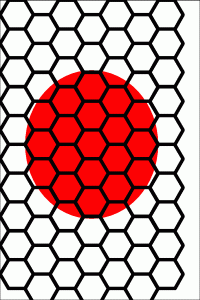
![]() New label
function FRAMECLOCK
New label
function FRAMECLOCK
This function creates a group of frames arranged as in a clock pattern, for example:
[group] = FRAMECLOCK(1, 1, 4, 7, 1, 1, 12)
ELLIPSE = 1, <group*>, #FF0000
This is the result:
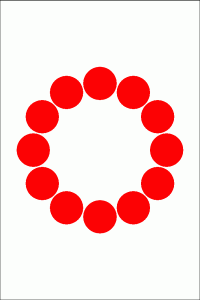
![]() Extract random frame(s) from a pool with "~"flag
Extract random frame(s) from a pool with "~"flag
This function selects a frame (or a group of frames) randomly from a group, for example:
[group] = FRAMECLOCK(1, 1, 4, 7, 1, 1, 12)
ELLIPSE = 1, <group*>, #FF0000
ELLIPSE = 1, <3~group*>, #0000FF
This is the result:
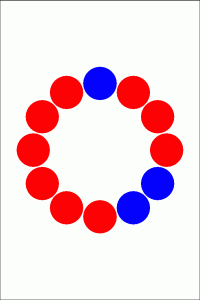
![]() Extract and delete frame(s) from a pool with "!" flag
Extract and delete frame(s) from a pool with "!" flag
This function selects a frame (or a group of frames) from a group, and deletes them from that group, for example:
[group] = FRAMECLOCK(1, 1, 4, 7, 1, 1, 12)
ELLIPSE = 1, <4!group*>, #FF00FF
ELLIPSE = 1, <4!group*>, #00FFFF
ELLIPSE = 1, <4!group*>, #FFFF00
This is the result:
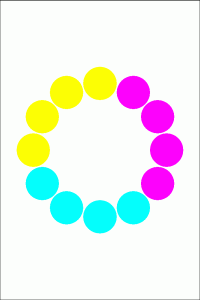
This flag can be combined with "~", for example:
[group] = FRAMECLOCK(1, 1, 4, 7, 1, 1, 12)
ELLIPSE = 1, <4!~group*>, #FF00FF
ELLIPSE = 1, <4!~group*>, #00FFFF
ELLIPSE = 1, <4!~group*>, #FFFF00
This is the result:
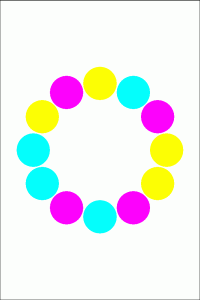
![]() Linked files
are saved with the main script
Linked files
are saved with the main script
Viewing a linked file with the "Linked data" button, if you make some change, the linked file will be saved with the main script when you press the "Save" button.
![]() New flags
for BORDER directive (for guidelines without card borders)
New flags
for BORDER directive (for guidelines without card borders)
For guidelines you can use the MARK (solid lines) e MARKDOT (dotted lines) flags to show them without card borders. For example:
ELLIPSE = 1-9, 0, 0, 6, 9, #FF0000
BORDER = NONE, #000000, 0, MARK
![]() New flags
for INPUTTEXT directive (for file browsing)
New flags
for INPUTTEXT directive (for file browsing)
With the INPUTTEXT directive you can use an F flag for browsing a file, and a G Flag for browsing a graphic file. For example:
INPUTTEXT = filename, "Pick an image:", , G
![]() Fixed bug
in CANVAS directive
Fixed bug
in CANVAS directive
![]() Fixed bugs in LINK/LINKMULTI directives
Fixed bugs in LINK/LINKMULTI directives